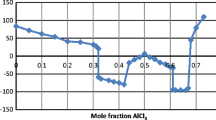Abstract
The authors present a phenomenological view on dielectric relaxation in polymer electrolytes. Polymer electrolytes are seen as molecular mixtures of an organic polymer and an inorganic salt. The following is based on systems with high molar mass poly(ethylene oxide) (PEO) and epoxidized natural rubber with 25 mol% of epoxide content (ENR-25) filled with lithium perchlorate (LiClO4). Dielectric properties of these systems have been studied as a function of salt content at room temperature. Additionally, properties of neat low molar mass PEO were studied as function of temperature. Relaxation-coined dielectric behavior rules the system with PEO in the frequency that ranged up to 106 Hz. Imaginary parts of impedance, tangent loss, and electric modulus spectra show distribution of relaxation times. Comparison of tangent loss (tan δ) spectra and imaginary part of electric modulus (M″) spectra reveals that localized motion dominates long-range motion of dipoles in the low-frequency range. However, discrepancy between them decreases with growing salt content. Scaling of tan δ spectra demonstrates that distribution of relaxation times does not depend on salt content in the range of low frequencies. The ENR-25 system exhibits solely relaxation like a macroscopic dipole. In conclusion, the system with PEO is characterized by individual relaxation of well-interacting dipoles, whereas the system based on ENR-25 is coined by immobilized dipoles that lead in the state of high-salt content to the relaxation behavior of a macroscopic dipole.
















Similar content being viewed by others
References
Bruce PG, Vincent CA (1993) Polymer electrolytes. J Chem Soc Faraday Trans 89(17):3187–3203. doi:10.1039/ft9938903187
Walkenhorst R, Selser JC, Piet G (1998) Long-ranged relaxations in poly(ethylene oxide) melts: evidence for network behavior. J Chem Phys 109(24):11043–11050. doi:10.1063/1.477743
Walter R, Walkenhorst R, Smith M, Selser JC, Piet G, Bogoslovov R (2000) The role of polymer melt viscoelastic network behavior in lithium ion transport for PEO melt/LiClO4 SPEs: the “wet gel” model. J Power Sources 89(2):168–175. doi:10.1016/s0378-7753(00)00426-2
Bruce PG, Hardgrave MT, Vincent CA (1992) Dc polarization of polymer electrolytes. Electrochim Acta 37(9):1517–1520. doi:10.1016/0013-4686(92)80102-R
Ibrahim S, Johan MR (2012) Thermolysis and conductivity studies of poly(ethylene oxide) (PEO) based polymer electrolytes doped with carbon nanotube. Int J Electrochem Sci 7:2596–2615
Singh TJ, Ganeshsanjeev, Siddappa K, Bhat SV (2004) Large enhancement of the ionic conductivity in an electron-beam-irradiated [poly(ethylene glycol)]xLiClO4 solid polymer electrolyte. J Polym Sci B Polym Phys 42(7):1299–1311. doi:10.1002/polb.20008
Florjańczyk Z, Zygadło-Monikowska E, Ostrowska J, Frydrych A (2014) Solid polymer electrolytes based on ethylene oxide polymers. Polimery 59:80–87. doi:10.14314/polimery.2014.080
Pradhan DK, Choudhary RNP, Samantaray BK (2008) Studies of structural, thermal and electrical behavior of polymer nanocomposite electrolytes. Express Polym Lett 2(9):630–638. doi:10.3144/expresspolymlett.2008.76
Bernson A, Lindgren J, Huang W, Frech R (1995) Coordination and conformation in PEO, PEGM and PEG systems containing lithium or lanthanum triflate. Polymer 36(23):4471–4478. doi:10.1016/j.bbr.2011.03.031
Marzantowicz M, Dygas JR, Krok F, Florjanczyk Z, Zygadlo-Monikowska E (2006) Influence of crystallization on dielectric properties of PEO:LiTFSI polymer electrolyte. J Non-Cryst Solids 352(42–49):5216–5223. doi:10.1016/j.jnoncrysol.2006.02.161
Chan CH, Kammer H-W (2016) On dielectrics of polymer electrolytes studied by impedance spectroscopy. Ionics 22(9):1659–1667. doi:10.1007/s11581-016-1700-7
Zhao Y, Wu C, Peng G, Chen X, Yao X, Bai Y, Wu F, Chen S, Xu X (2016) A new solid polymer electrolyte incorporating Li10GeP2S12 into a polyethylene oxide matrix for all-solid-state lithium batteries. J Power Sources 301:47–53. doi:10.1016/j.jpowsour.2015.09.111
Abdul Nasir NH, Chan CH, Kammer HW, Sim LH, Yahya MZA (2010) Ionic conductivity in solutions of poly(ethylene oxide) and lithium perchlorate. Macromol Symp 290(1):46–55. doi:10.1002/masy.201050406
Chan CH, Kammer H-W, Sim LH, Nasir NHA, Winie T (2012) On the thermodynamics of solid solutions of polymer and salt. Polym Eng Sci 52(11):2277–2284. doi:10.1002/pen.23290
Chan CH, Kammer H-W, Sim LH, Mohd Yusoff SNH, Hashifudin A, Winie T (2014) Conductivity and dielectric relaxation of Li salt in poly(ethylene oxide) and epoxidized natural rubber polymer electrolytes. Ionics 20(2):189–199. doi:10.1007/s11581-013-0961-7
Lascaud S, Perrier M, Vallee A, Besner S, Prud'homme J, Armand M (1994) Phase diagrams and conductivity behavior of poly(ethylene oxide)-molten salt rubbery electrolytes. Macromolecules 27(25):7469–7477. doi:10.1021/ma00103a034
Lemaitre-Auger F, Prud'homme J (2001) Ion–ion, short-range interactions in PEO-LiX rubbery electrolytes containing LiSCN, LiN(CF3SO2)2 or Li[CF3SO2N(CH2)3OCH3] as deduced from studies performed on PEO-LiX-KX ternary systems. Electrochim Acta 46(9):1359–1367. doi:10.1016/S0013-4686(00)00720-9
Debye PJW (1929) Polar Molecules. Chemical Catalog Company [reprinted by Literary Licensing (LLC) 2012], New York
Chan C, Kammer H-W (2015) Polymer electrolytes—relaxation and transport properties. Ionics 21(4):927–934. doi:10.1007/s11581-014-1256-3
Kammer H-W, Harun MK, Chan CH (2015) Response of polymer electrolytes to electric fields. IJIMM 2(1):268–291
Pulst M, Kressler J (2014) unpublished data after Pust, M. MSc Thesis (2014) Characterization of linear and cross-linked poly(ethylene oxide); Martin-Luther University Halle-Wittenberg, Germany
Author information
Authors and Affiliations
Corresponding author
Rights and permissions
About this article
Cite this article
Chan, C.H., Kammer, HW. Impedance spectra of polymer electrolytes. Ionics 23, 2327–2337 (2017). https://doi.org/10.1007/s11581-017-2174-y
Received:
Accepted:
Published:
Issue Date:
DOI: https://doi.org/10.1007/s11581-017-2174-y




